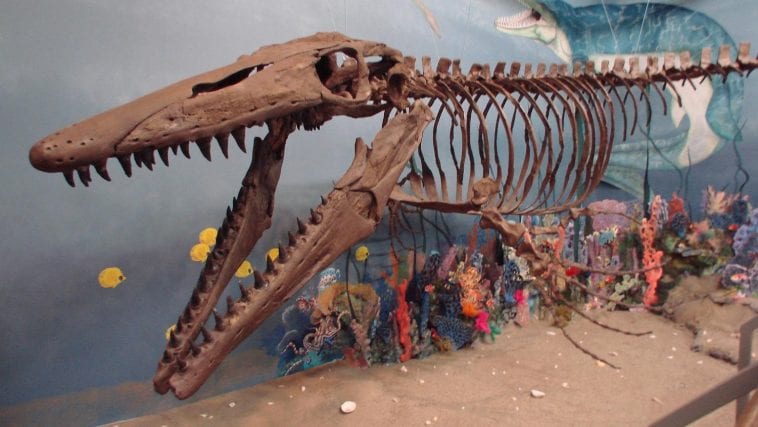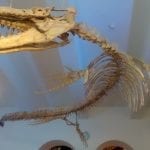Essay by Carly Larson
Genesis 1 tells us that God created everything from the heavens to the creatures of the sea, from light itself to tiny little insects. This would also include dinosaurs.
While you may be familiar with dinosaurs such as the Triceratops or the Tyrannosaurus Rex, the Mosasaur is truly an amazing creature designed by God. Popularized by the movie series, Jurassic World, “Mosy” was a minor protagonist who only fed when entertaining the tourists. This has led many dinosaur enthusiasts to research the Mosasaur’s unique qualities.
Discovery
The first Mosasaur fossil remains were found in the southern Netherlands on the Meuse River in a limestone quarry in 1764 by Lieutenant Jean Baptiste Drouin. History records that in 1795 the remains were confiscated by the French army in exchange for several cases of wine. To this day the skeletal remains still stand inside Paris’s French National Museum.
We have found Native American cave drawings of giant lizards resembling the Mosasaur, and Plioplatecarpus fossil specimens, which is a genus (a group or kind with common attributes) of the Mosasaurus lizard, have been discovered in both North America and Europe. This causes scientists to assume that the Mosasaur could have been found in most oceans around the world, making this creature an open ocean predator.
General Features
Scientists estimate that the Mosasaur had a life span of about 42 years and could weigh 40,000+ pounds. They had large skulls and long snouts like a crocodile and their backbone consisted of over 100 vertebrae.
Many Mosasaurs were large, exceeding 9 meters [30 feet] in length, but the most common forms were most likely no larger than modern-day porpoises. The length of the largest Mosasaurs was even greater than the fearsome Tyrannosaurus Rex since the largest T-Rex fossil, found in Canada and nicknamed “Scotty,” was about 42 feet long. The largest discovered specimen of Mosasaur had a length of about 56 feet or about as long as the North Pacific Right Whale.
The Mosasaur was a carnivorous aquatic hunter, and its prey was most likely fish, marine reptiles, birds, pterosaurs, smaller mosasaurs, and maybe even land dinosaurs. They were powerful swimmers and spent most of their time near the ocean surface since they breathe air in a similar fashion as whales do today. It is possible these creatures could have lived in either salt or freshwater because they breathed air.
Fearsome Jaws
The Mosasaur’s jawbone is notable in that they are jointed near mid-length and connected in the front by ligaments only. This arrangement of the jaw enables the animal to not only open its mouth by lowering the mandible (the lower jaw of a vertebrate animal) but also to extend the lower jaw sideways while feeding on large prey.
The jaws also conceal conical (cone-shaped) and slightly recurved teeth set in individual sockets. These toothy secret weapons are called pterygoid or flanged teeth that would have been used to help the Mosasaur handle and swallow its prey whole. The jaw is also double hinged which would have also assisted in their consumption of larger prey.
Paleontologists believe that the Mosasaur had live births, just like whales, instead of laying eggs. This theory was confirmed when scattered remains of several fossilized unborn young were discovered around a pregnant Plioplatecarpus body, nicknamed “The Mother Mosasaur” in South Dakota.
Conclusion
God designed these creatures with unique and special qualities that make them different from any other animal in the entire world. Fossils allow us to see into the past to these truly massive creatures.
Standing under one of these amazing Mosasaur fossils in Glendive, Montana at the Glendive Dinosaur and Fossil Museum, one can really appreciate their intimidating size.
Author’s Bio:
Carly is 16 and a homeschooling Sophomore. She is actively involved in her church youth group and is busy with this summer’s VBS outreach. She enjoys drama, audiovisual technology, and loves to fly fish with her dad.






